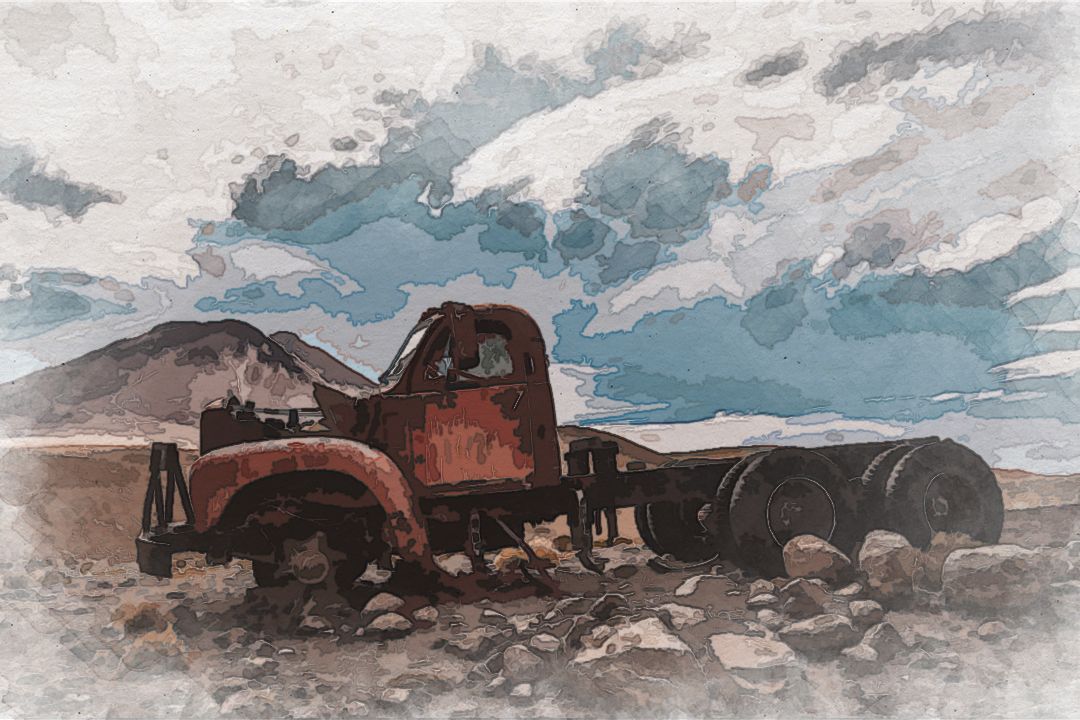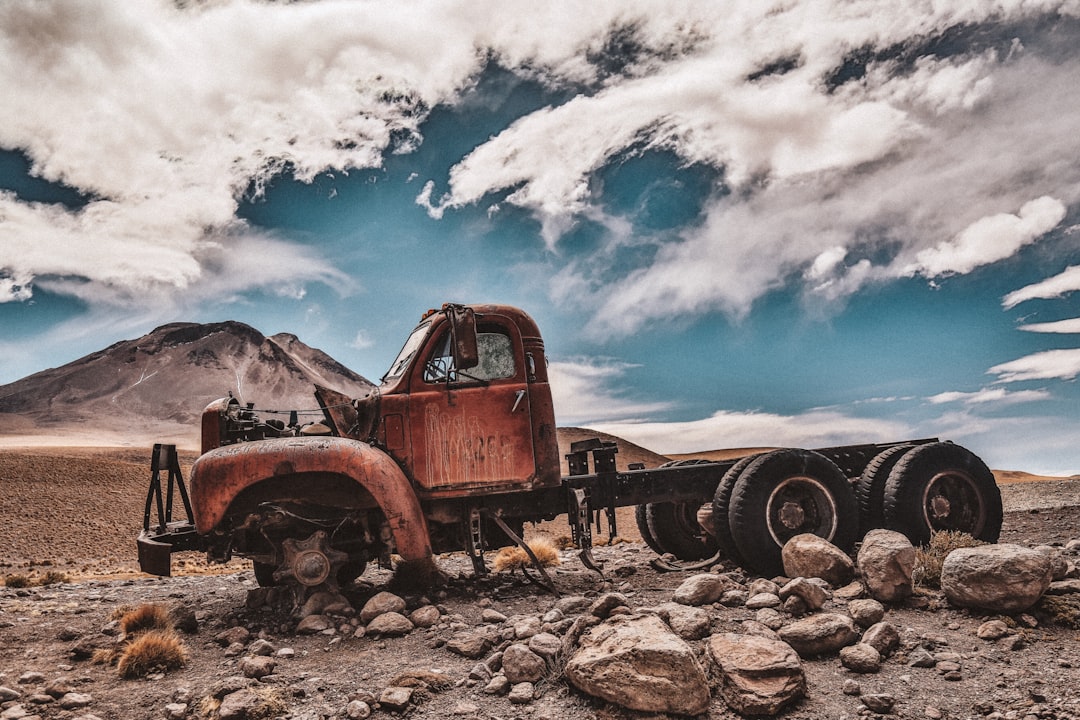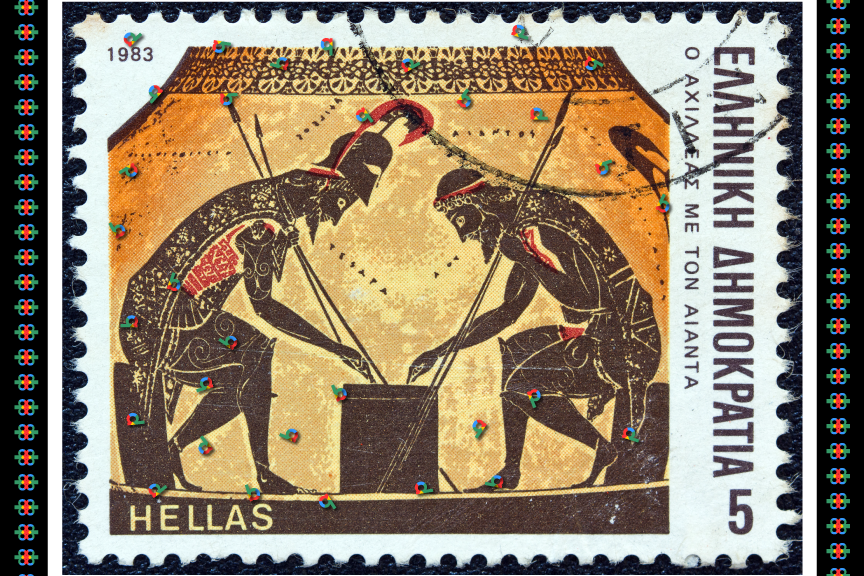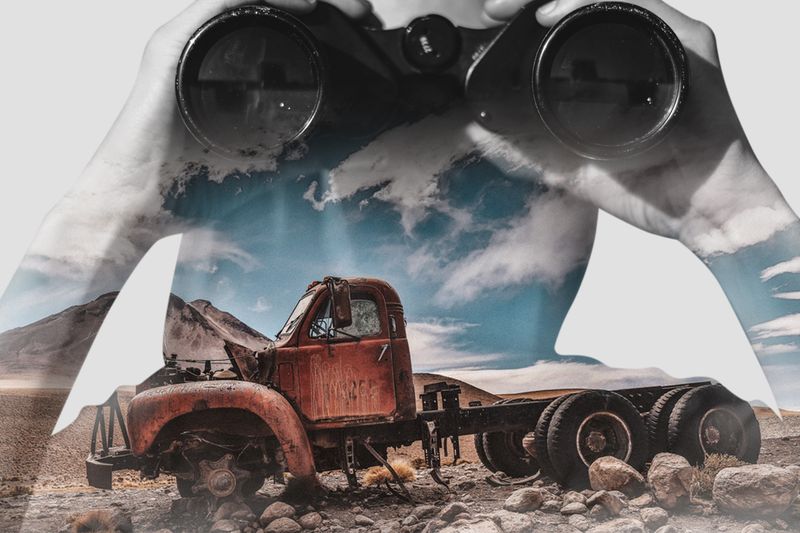The Theory of Everything is but a TOE in the Ocean

A Broken T.O.E. and a Theory Worth Discovering
In the desert's expanse, where time seemed to stretch endlessly under the scorching sun, a lone figure stood with binoculars. The person, a solitary wanderer, surveyed the desolate landscape with curiosity and contemplation. In the background, a faded tow truck lay abandoned, its rusted frame telling tales of bygone journeys and abandoned hopes.
To myself, I am only a child playing on the beach while vast oceans of truth lie undiscovered before me.
— Isaac Newton (1643-1727)
Was this observer seeking help for the stranded tow truck or merely admiring the beauty of isolation?
As the scene faded into a distant memory, the rusted tow truck slipped from consciousness, becoming a mere blur on the canvas of forgotten dreams. The wanderer, now lost in the vastness of the desert, grappled with the metaphorical weight of a Broken T.O.E. (Theory of Everything) that seemed to echo in the emptiness around.
Blessed is he who expects nothing, for he shall never be disappointed.
— Alexander Pope (1688-1744)
As the winds whispered the timeless wisdom of Alexander Pope, the arid landscape seemed to respond with a subtle symphony of rustling leaves and swirling dust. The solitary wanderer, standing amidst the vastness of the desert, felt the weight of those words settling around them like a gentle caress. The air carried not just the dry whispers of the desert, but the accumulated knowledge of ages, as if the particles of dust held the secrets of philosophers long gone.
The wanderer's gaze softened once fixed on the distant horizon with expectations and uncertainties. The mirages that danced on the edges of the perception began to dissipate, blending seamlessly into the undulating waves of the desert floor. It was as though the landscape itself conspired to teach a profound lesson.
In that moment, the wanderer's expectations, like fleeting mirages, dissolved into the vast openness of the present. The burden of anticipation lifted, leaving behind a canvas unblemished by preconceived notions. The air, now pregnant with the raw essence of the desert, carried the scent of sagebrush and the warmth of sunbaked earth.
The play of sunlight on the dunes painted a kaleidoscope of shifting shadows, casting an ever-changing tapestry upon the sand. The wanderer, liberated from the shackles of expectation, became attuned to the subtleties of the surroundings—the delicate footprints of a passing creature, the rhythmic dance of tumbleweeds in the breeze, and the silent whispers of time etched into the rocks.
The realization that blessedness lay in expecting nothing began to settle in the wanderer's soul. It was not a resignation to apathy but an embrace of the richness inherent in the uncharted moment. In its vast solitude, the desert unfolded as a canvas inviting the wanderer to be an active participant, a co-creator in the ongoing masterpiece of existence.
As the wanderer moved through the landscape, the simplicity of the moment became a source of profound joy. The winds continued their whispering, now a melodic refrain that celebrated the act of being present in the desert's embrace. The shifting sands beneath their feet echo the transient nature of expectations, constantly evolving and reshaping with time.
In the quiet expanse of the desert, the wanderer discovered a newfound freedom—a freedom born from releasing the burden of anticipated outcomes. Now a gentle companion, the wind carried not only the wisdom of ages but also the joy of living in the unadorned reality of the now. The wanderer, blessed by the serenity of expectation-free existence, continued their journey, each step a testament to the beauty of embracing the raw essence of the present moment in the heart of the timeless desert.
In a sudden shift, the scene snapped back into focus—the urgency of fixing what lay right before the wanderer became evident. The broken tow truck symbolized shattered dreams and stalled progress demanded attention.
The great art of life is sensation, to feel that we exist, even in pain.
— Lord Byron (1788-1824)
The tow truck, a relic of forgotten journeys and untold stories, silently witnessed the wanderer's contemplation. The hands, weathered by the elements and marked by the journey through life's vicissitudes, reached out tentatively to touch the rusty metal. There was a palpable communion between the wanderer and the wounded vehicle—an unspoken acknowledgment of shared existence marred by the scars of time.
As the fingertips grazed the rough surface, the sensation of existence surged through the wanderer's being. It was a tactile dance with reality, a reminder that even in the face of adversity and decay, the ability to feel, to connect with the tangible world, was a testament to the richness of life. The rusty metal, cool to the touch, conveyed the history of the tow truck and the shared vulnerability of all things subject to the relentless march of time.
The sensation of existence extended beyond the physical touch—it resonated in the creaking protests of the tow truck's worn parts, the scent of aged metal mingling with the arid air, and the play of sunlight casting fleeting shadows upon the rusted surface. With each tactile interaction, the wanderer became a participant in the living canvas of the desert, a collaborator in the ongoing masterpiece of life's sensations.
Lord Byron's words, now more than an echo, became a living mantra. The wanderer, fully immersed in the present moment, embraced the pulsating rhythm of existence, even when draped in the fabric of pain. The ailing tow truck, once a symbol of mechanical failure, transformed into a conduit for the wanderer's connection with the very essence of being.
The boundaries between self and other blurred in this silent communion between wanderer and machine. The great art of life unfolded not as a distant concept but as an intimate, hands-on experience. The desert, with its vast expanses and ancient whispers, bore witness to this tactile celebration of existence—a celebration that transcended the limitations of pain and adversity.
One of the first signs of the beginning of understanding is the wish to die.
— Franz Kafka (1883-1924)
The stark truth of Franz Kafka's words whispered through the wanderer's mind as they faced the broken-down tow truck. A mechanical failure and a metaphorical breakdown triggered a desire to grasp and overcome the challenges.
Tools clinked, gears turned, and the wanderer battled with the mechanical puzzle. It wasn't just fixing the truck but tackling the breakdowns life throws. Kafka's insight fueled the determination to understand, not in a morbid sense, but as a drive to comprehend the complexities mirrored in the malfunctioning tow truck.
As bolts tightened and gears realigned, the desert became the silent witness to a struggle against adversity. The wish to die wasn't about giving up but shedding the old self for a new understanding. The repair, marked by sweat and perseverance, symbolized victory over the breakdown's hold.
With the engine's hum marking the end of the battle, Kafka's truth transformed. The wish to die wasn't defeat but a prelude to rebirth. The desert witnessed the wanderer's resilience, highlighting that breakdowns were not just hurdles but opportunities for understanding and the birth of new possibilities.
Never confuse a single defeat with a final defeat.
— F. Scott Fitzgerald (1896-1940)
As bolts were tightened and parts replaced, the desert winds carried not just grains of sand but also the determination to rise above setbacks. Each repaired component was a testament that defeat wasn't an endpoint but a mere detour on the journey toward triumph.
The vastness of the desert, with its unyielding expanse, mirrored the expansiveness of possibilities. The observer, amid the inhospitable terrain, understood that every broken piece was a chance to learn and improve. Fitzgerald's words weren't just echoing; they guided the observer to persist in adversity.
Once shattered and scattered, the repaired parts fit together like a mosaic of persistence. With hands marked by effort, the observer stood back to witness a fixed mechanism and a metaphorical victory over the defeat that had threatened to be final.
In the profound silence of the desert, Fitzgerald's wisdom had transformed from a distant echo to a living truth. Each broken part, once perceived as a potential end, became a stepping stone towards a new beginning. The vastness of the desert, now less intimidating, seemed to applaud the observer's resolve to rise above defeats, reminding them that in the desert of setbacks, the oasis of triumph is found not by surrendering but by persisting.
I believe that a scientist looking at nonscientific problems is just as dumb as the next guy.
— Richard Feynman (1918-1988)
Amidst the clinks of tools and the hum of gears, the wanderer was at a crossroads of understanding. The scientific mindset, invaluable in its own right, proved insufficient in deciphering the nuanced complexities of life's challenges. The desert, with its unforgiving terrain, mirrored the unpredictable nature of these puzzles.
As the wanderer navigated through the endeavour, a light-hearted thought crossed their mind. The juxtaposition of scientific precision against life's uncertainties sparked a moment of humour amid the serious pursuit. It was a realization that, despite being well-versed in the intricacies of scientific problems, tackling the enigma of life required more than just equations and logic.
The wanderer chuckled, acknowledging the inherent limitation of their scientific lens when confronted with the whimsical chaos of existence. The light-hearted thought became a beacon of humility, recognizing that intelligence in one domain didn't necessarily guarantee brilliance in navigating the vast landscape of nonscientific problems.
In mechanical troubleshooting, the wanderer's mind briefly flirted with the whimsical notion that even the most brilliant scientists might feel just as clueless as the next person when faced with the perplexities of life. With its timeless vastness, the desert seemed to encourage this moment of levity, offering a respite from the weight of the challenges.
As tools continued their work, the wanderer approached the nonscientific problems with a newfound openness. The light-hearted realization catalyzes a more holistic perspective, blending scientific acumen with a touch of humanity. The desert winds, echoing Feynman's wisdom and the wanderer's laughter, witnessed the endeavour's evolution.
I don't know who invented high heels, but all women owe him a lot.
— Marilyn Monroe (1926-1962)
Perhaps, just like high heels, the journey of fixing the broken tow truck was a feat deserving of acknowledgment and gratitude.
Ultimately, as the tow truck returned to life, the wanderer stood victorious in the vast desert. A Theory Worth Discovering was not just about the mechanical intricacies of a tow truck but the profound realization that life's brokenness could be mended with perseverance, understanding, and a touch of humour. Once a desolate canvas, the desert now bore the marks of resilience, mirroring the wanderer's triumph over challenges and the discovery of untold truths in the journey through the arid expanse.
As the tow truck's engine roared to life, breaking the desert's silence, the wanderer stood back, gazing at the once-forgotten vehicle now resurrected. The metaphorical and mechanical journey spanned the vast canvas of the desert, revealing layers of truths and challenges.
The wanderer's mind drifted back to the beach, to the child playing at the shore, oblivious to the vast oceans of undiscovered truth. In this moment of triumph, the realization echoed:
To myself, I am only a child playing on the beach while vast oceans of truth lie undiscovered before me.
— Isaac Newton (1643-1727)
Once a forsaken relic, the tow truck had transformed into a beacon of possibilities. Its repaired frame stood as a testament to the wanderer's ability to navigate the challenges, much like a child daring to venture into the unknown depths of the shoreline. The desert, mirroring the endless possibilities of the undiscovered, stretched out before the wanderer like a canvas waiting to be painted with the hues of exploration.
Having carried the wisdom of ages across the arid landscape, the winds whispered again. It was as if the desert acknowledged the triumph, offering its silent applause to the wanderer's conquest over mechanical and metaphorical breakdowns. The echoes of Newton's words reverberated in the breeze, emphasizing that, like a child with the vast ocean of truth before them, the journey of exploration was beginning.
The wanderer, now both conqueror and explorer, felt the weight of newfound wisdom settling within. The tow truck, once a symbol of despair, now served as a vessel sailing on the boundless sea of possibilities. Each gust of wind carried not only the tales of ages past but also the anticipation of adventures yet to unfold.
In this moment of triumph, the wanderer embraced the childlike curiosity that Newton spoke of. This curiosity propelled them forward into the uncharted territories of the desert and the unexplored depths of life's mysteries. The repaired tow truck, poised against the backdrop of the expansive landscape, symbolized not just a conquest but an invitation to continue playing on the beach of undiscovered truths.
As the winds whispered their ancient secrets, the wanderer entered the desert's embrace with a renewed sense of wonder. The vastness, once a challenge, now became an open invitation to explore the limitless possibilities on the horizon. The beach of undiscovered truths awaited, and the wanderer, much like the child described by Newton, ventured forth with the tireless spirit of curiosity, ready to uncover the mysteries that lay beyond the dunes.
Blessed is he who expects nothing, for he shall never be disappointed.
— Alexander Pope (1688-1744)
The wanderer, after ditching expectations, stood before the fixed tow truck. The repaired vehicle wasn't just a mechanical win but a triumph over past letdowns.
As the wanderer appreciated the revived tow truck, the simplicity of the present became a source of joy. Dumping expectations freed them to enjoy the success at hand. The desert showcased this newfound freedom with its vastness, and the wanderer relished the moment's beauty.
After the repair, the desert's quiet offered a moment to think. The winds carried ancient wisdom and the tow truck's humming success. The wanderer found peace in the quiet, a break from the previous disappointment.
The realization lingered—being blessed by expecting nothing wasn't emptiness but an opportunity to appreciate each moment. Once a source of frustration, the fixed tow truck stood resilient, proving that letting go of expectations led to unexpected victories.
With its undisturbed beauty, the desert became a place for the wanderer's thoughts. The quiet, broken only by the desert breeze, mirrored the peace found in shedding expected outcomes.
The wanderer carried this newfound wisdom as the sun set, colouring the desert. The tow truck, surrounded by the vast expanse, testified to the strength of letting go of expectations and finding peace in the present. The journey, once burdened by the heavy expectations of success, now unfolded as a simple exploration, guided by the blessing of expecting nothing and appreciating the beauty that emerged from that simplicity.
The great art of life is sensation, to feel that we exist, even in pain.
— Lord Byron (1788-1824)
As the wanderer pondered the tough moments of the journey, the desert sunset cast long shadows. Despite the challenges, the desire to understand echoed in the quiet. The fading light brought reflection, not just on the struggles but on the resilience needed to face them.
Even in moments of despair, the wish to understand persisted. The desert, usually silent, became a space for contemplation. The wind carried the wanderer's silent questions and the tranquillity of the dusk.
The journey's tough times were acknowledged, not ignored. Each challenge added a layer to the wanderer's experience. Byron's idea that life's art is to feel, even when it hurts, made sense as the wanderer embraced the depth of their emotions, even amidst difficulties.
In the quiet desert, the wish to understand became a symbol of resilience as the sun disappeared. It was an acknowledgment that, even in tough moments, there's an opportunity for growth. The shifting sands beneath the wanderer's feet represented the changing nature of challenges and the temporary nature of pain.
As the last light faded, the wanderer, surrounded by the evening glow, carried the weight of the journey's hardships and a growing understanding of existence. Byron's words were more than eloquence; they were a reminder that the essence of life lies not just in joyous moments but also in acknowledging and feeling our own experiences, even in pain and uncertainty.
One of the first signs of the beginning of understanding is the wish to die.
— Franz Kafka (1883-1924)
Franz Kafka's words lingered in the wanderer's mind as they faced the broken tow truck. Initially frustrating, the mechanical failure triggered a fleeting desire to escape the challenge. However, that vulnerability became a starting point for understanding.
The broken tow truck, once a source of irritation, now pushed the wanderer to unravel life's complexities. It became a tangible representation not just of a physical breakdown but also of the metaphorical challenges one encounters on the journey.
The wanderer grappled with the puzzle as the tools clinked during the repair. The wish to die wasn't an end but hinted at the beginning of comprehension—a shedding of the old self. The tow truck breakdown became a representation of life's intricate web.
After the repair, the tow truck stood as a monument to resilience in the desert. Each fixed part symbolized victory over emotional hurdles that initially seemed insurmountable.
The lessons echoed in the desert's stillness as the wanderer considered the repaired tow truck. Each setback had become a stepping stone toward fixing what initially seemed irreparable. The repaired vehicle stood as a reminder that mechanical or metaphorical breakdowns were not conclusive defeats but growth opportunities.
In the desert's solitude, under a starry sky, the wanderer pondered the interconnectedness of challenges and understanding. The broken tow truck served not just as transportation but as a vehicle for the wanderer's journey toward enlightenment. The wish to die transformed into a wish for rebirth, symbolizing a profound shift in perspective amidst tools, gears, and the vastness of the desert night.
Never confuse a single defeat with a final defeat.
— F. Scott Fitzgerald (1896-1940)
Each setback, every moment of despair, was a stepping stone toward the ultimate triumph of fixing what initially seemed irreparable.
In the solitude of the desert night, under a sky ablaze with stars, the wanderer pondered the interconnectedness of science and life.
The challenges were not confined to equations and logic; they were profound puzzles that required a holistic understanding and a blend of scientific and human perspectives.
Amidst these contemplations, a whimsical thought surfaced – the invention of high heels.
I don't know who invented high heels, but all women owe him a lot.
— Marilyn Monroe (1926-1962)
This humorous observation brought a smile to the wanderer's face, a reminder that a touch of lightheartedness could be a source of strength even in the most serious endeavours.
As dawn painted the desert in hues of gold and pink, the wanderer stood amid the vast expanse, a transformed landscape reflecting the resilience of the human spirit. The Broken T.O.E., once a weighty burden, had given way to a Theory Worth Discovering – a theory of overcoming, adapting, and finding beauty in desolation.
Having navigated the intricacies of the desert and the complexities of the broken tow truck, the wanderer walked away with more than just a functional vehicle. In the heart of the arid landscape, a profound journey had unfolded, revealing the depths of human resilience, the interconnectedness of science and life, and the enduring power of laughter in the face of challenges.
As the wanderer ventured into the horizon, leaving the resurrected tow truck behind, the desert echoed with the whispers of ancient wisdom and the laughter of a triumphant soul, carrying the Theory Worth Discovering into the vast, undiscovered truths that lay ahead.

The planksip Writers' Cooperative is proud to sponsor an exciting article rewriting competition where you can win over $750,000 in prize money.
Figures of Speech Collection Personified
Our editorial instructions for your contest submission are simple: incorporate the quotes and imagery from the above article into your submission.
What emerges is entirely up to you!
Winners receive $500 per winning entry multiplied by the article's featured quotes. Our largest prize is $8,000 for rewriting the following article;

At planksip, we believe in changing the way people engage; at least, that's the Idea (ἰδέα). By becoming a member of our thought-provoking community, you'll have the chance to win incredible prizes and access our extensive network of media outlets that will amplify your voice as a thought leader. Your membership truly matters!


